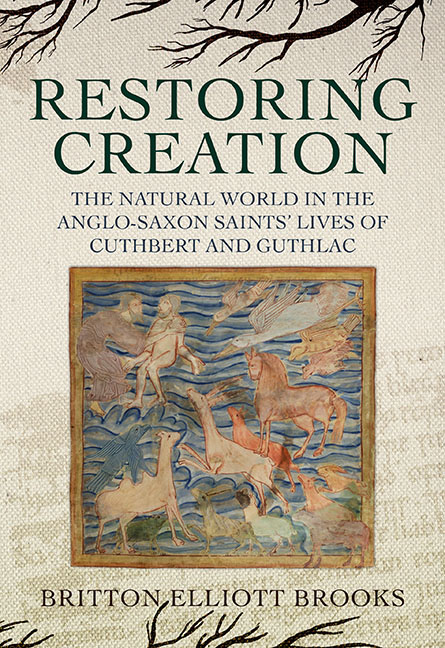 Restoring Creation: The Natural World in the Anglo-Saxon Saints' Lives of Cuthbert and Guthlac
Restoring Creation: The Natural World in the Anglo-Saxon Saints' Lives of Cuthbert and Guthlac Book contents
- Frontmatter
- Contents
- Acknowledgements
- Abbreviations
- Introduction
- 1 Monastic Obedience and Prelapsarian Cosmography: The Anonymous Vita Sancti Cuthberti
- 2 Ruminative Poetry and the Divine Office: Bede's Metrical Vita Sancti Cuthberti
- 3 Bede's Exegesis and Developmental Sanctity: The Prose Vita Sancti Cuthberti
- 4 Enargaeic Landscapes and Spiritual Progression: Felix's Vita Sancti Guthlaci
- 5 Landscape Lexis and Creation Restored: The Old English Prose Life of Guthlac and Guthlac A
- Conclusion: Afterlives of Cuthbert and Guthlac
- Bibliography
- Index
Conclusion: Afterlives of Cuthbert and Guthlac
Published online by Cambridge University Press: 18 September 2019
- Frontmatter
- Contents
- Acknowledgements
- Abbreviations
- Introduction
- 1 Monastic Obedience and Prelapsarian Cosmography: The Anonymous Vita Sancti Cuthberti
- 2 Ruminative Poetry and the Divine Office: Bede's Metrical Vita Sancti Cuthberti
- 3 Bede's Exegesis and Developmental Sanctity: The Prose Vita Sancti Cuthberti
- 4 Enargaeic Landscapes and Spiritual Progression: Felix's Vita Sancti Guthlaci
- 5 Landscape Lexis and Creation Restored: The Old English Prose Life of Guthlac and Guthlac A
- Conclusion: Afterlives of Cuthbert and Guthlac
- Bibliography
- Index
Summary
At the heart of the various vitae of Cuthbert and Guthlac explored in this study lies the relationship of the saints with Creation which, I have argued, was fundamental to their role as saints. While sometimes regarded as only an allegorical signifier for heavenly ideas, Creation in these early vitae functioned in a much more complex and physical way. Sanctity was achieved and experienced within delineated portions of the Anglo-Saxon landscape. Though each text under consideration engages with Creation in different ways, their shared Augustinian/Bedan exegesis frames their saints’ interactions with Creation, and allows for a comparative analysis that lends the distinctions weight and colour. Given the constraints of space, this study necessarily excludes the later traditions of both saints. The findings outlined here, however, invite further analysis on the role of Creation within the later literary iterations of the Cuthbertine and Guthlacian cults, pointing the way for further study. I will consider briefly some of them below.
Saint Cuthbert's popularity continued throughout the medieval period, and the central role of the relationship between Cuthbert and Creation remained. This is evidenced, for example, in the late Old English poem Durham, which focuses on the city that by the time of the poem's composition was the resting place for both Cuthbert and his cult. While the poem has often been interpreted as an encomium urbis for the city, Helen Appleton has persuasively argued that though it utilises this form, Durham is better understood as focusing on Cuthbert himself. Durham opens with a description of the city that emphasises the physical landscape in which it resides, highlighting two distinct features that echo the depictions of Creation in the vitae of Cuthbert: first, with regard to the landscape itself, Durham is surrounded by water, an echo of both Lindisfarne and Farne; second, the waters, wooded hills, and dales are overflowing not simply with animate life, but specifically with wild animals that are part of the positive description.
- Type
- Chapter
- Information
- Restoring Creation: The Natural World in the Anglo-Saxon Saints' Lives of Cuthbert and GuthlacThe Natural World in the Anglo-Saxon Saints’ Lives of Cuthbert and Guthlac, pp. 287 - 292Publisher: Boydell & BrewerPrint publication year: 2019
